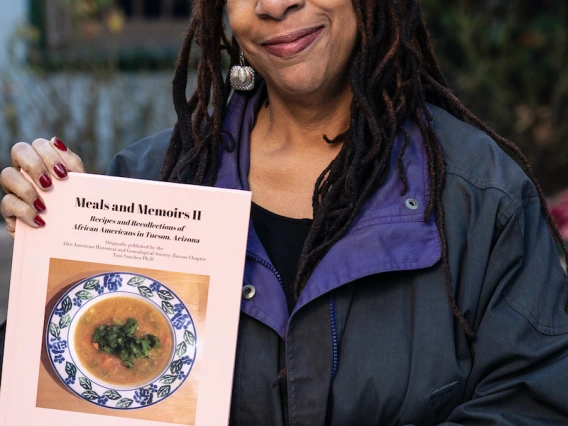
A generation ago, the local chapter of the Afro-American Historical and Genealogical Society published a collection of recipes, family stories and historical details spanning a century of Black life in Tucson.
Tani Sanchez, then-president of the group, suggested the cookbook as a way to raise funds for the chapter, but along the way, the assembled recipes and autobiographical essays about Black life in Tucson, especially from "the movers and shakers of the '40s and '50s," grew rich with stories that otherwise might never have found their way to the public.
"The first edition was absolutely charming," said Sanchez, who was raised in Tucson. "We got (contributions from) a lot of people and information and it really gives you a history of Tucson and some feel for what Black people were eating and doing."
A few years ago, only two copies of the 1993 book remained unsold and Sanchez, now a University of Arizona Professor of Practice in Africana Studies, sought to produce an expanded second edition, updating the book with new health-conscious recipes and additional interviews, recollections and living histories from the Black community.
Sanchez started working on the updated edition as part of a series of projects funded by a $100,000 grant from the Agnese Nelms Haury Program in Environment and Social Justice to the Dunbar Coalition, the nonprofit group that transformed the former segregated Dunbar School into a community center. With a portion of the grant, Sanchez hired students majoring in Africana studies to conduct interviews and gather community stories. Dunbar Pavilion associates and Megan Carney, director of the university's Center for Regional Food Studies, also provided input.
"A relatively small group, African Americans nonetheless form a distinct part of the fabric of this city. We count and we make a difference in all the ways that Black people always have," Sanchez writes in the book's opening pages. "We have challenged norms, added to the wisdom that comes from differing standpoints, and offered cultural expressions that enrich everyone in multiple ways."
Sanchez contributed her own recipes – for buffalo wings and spicy barbecue ribs – and said she has enjoyed making other recipes from the book. While sweet potato pie has long been an African American tradition, it wasn't a part of her own family's tradition. So, she made pies following the cookbook's recipe and shared slices with members of her church, many of whom said the pies were contest-winning quality.
"I was so pleased that these particular recipes I tried were satisfying to a very discriminating group," said Sanchez, who has also published a genealogy of her family, "Didn't Come From Nothing: An African American Story of Life."
Jerome Dotson, an Assistant Professor of Africana Studies, called the book an "indispensable text," because there are so few histories of Black life in Tucson. Dotson, whose research in part deals with the cultural, social and political significance of eating and diet on Black life in America from slavery to the present, wrote a new introduction for the book, emphasizing that integrating recipes with details of Black history in Tucson is an ideal way to capture day-to-day life.
"From Booker T. Washington to Dr. Alvenia Fulton and Dr. James Mays, Black Americans have had a long tradition of connecting nutrition to longer lives," Dotson writes. "In a similar vein, the contributors to 'Meals and Memoirs II' acknowledge the importance of Black American culinary traditions while fostering healthier versions of long-beloved dishes."
The original and updated versions of the cookbook both include an overview of Black history in Tucson, beginning with Estevan, the first African to explore North America, and Mr. and Mrs. Wiley Box, two of the first recorded Black settlers, who arrived in Tucson between 1850 and 1855. Over the next century, the Paul Laurence Dunbar School, churches like Mount Calvary and Mount Olive, and neighborhoods like Sugar Hill became central to Black life in Tucson.
"Meals and Memoirs II" picks up the history where the first edition left off. Today, the former segregated Dunbar School is the Dunbar Pavilion, an arts and cultural center that's still a focal point for the Black community. The book includes interviews with community members on many significant aspects of Black life in Tucson over the last 30 years, including student activism at the University of Arizona and Pima Community College, the impact of Black military personnel stationed in Southern Arizona, the impact of the COVID-19 pandemic on Black business owners and community connections, and the influence of immigrants from Africa.
"This is a book with the original purpose intact—to combine history, biographical snippets, and recipes of a local population," Sanchez writes in the book. "It offers new recipes and new stories alongside the old ones. These living histories encompass concerns such as the COVID-19 pandemic, contemporary health cuisine concerns and just a touch of Black social protests. 'Meals and Memoirs II' tells a story of a Black people in Arizona still living, influencing, generating, and surviving as they create distinct meals and wonderful stories that all can savor."

